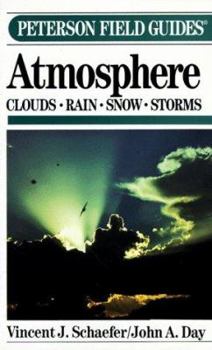Peterson Field Guide (R) to Atmosphere
(Book #26 in the Peterson Field Guides Series)
Select Format
Select Condition 
Book Overview
More than 400 photographs and line drawings illustrate every kind of atmospheric phenomenon: clouds of every type; storms, from cloudbursts to hurricanes; and sky colors. This description may be from another edition of this product.
Format:Paperback
Language:English
ISBN:0395330335
ISBN13:9780395330333
Release Date:January 1981
Publisher:Houghton Mifflin
Length:359 Pages
Weight:0.79 lbs.
Dimensions:1.0" x 4.5" x 7.2"
Customer Reviews
3 ratings
Definitely not for kids
Published by Cst , 1 year ago
It’s in terrible condition. The words are so small you need a magnifying glass to read. Pages are yellow and dingy. Not in what I would consider “Like New” condition.
Weather & Smart, too!
Published by Thriftbooks.com User , 15 years ago
This book should not be confused with other "cloud spotting" books. It isn't about "garden-variety" storms either. Rather, it is a palatable introduction to the atmospheric sciences aimed at naturalists and educators. While the authors occasionally struggle with maintaining the flow and organization of the book in delivering some very complex topics, they manage to keep the material interesting and enjoyable to read. Someone completely uninitiated with the atmosphere will come away from this book with a greater appreciation of everyday weather through an understanding of the localized chemical processes that produce it. A Neat Book!
Worthwhile for the "Everyday" cloud-watcher
Published by Thriftbooks.com User , 21 years ago
This is a useful weather field guide because it spends most time illustrating regular weather phenomena. By that, I mean it spends most time on the various types of clouds, "garden-variety" thunderstorms, and ordinary optical phenomena like rainbows, irridescence, halo(e)s, and the like - the kind of stuff you're most likely to see if you glance out your bedroom window of a morning, or . . . whatever. (It's hard not to sound corny there!)Also, the text goes into how such phenomena comes about, which is useful.There are also useful appendices like the Beaufort scale, and tornado safety rules in the back.The only drawbacks are, the fact that this isn't a full-color guide: the color plates have been segregated to an insert around the middle of the book, which makes up perhaps an eighth of the book - if that (all other photos - the majority of the book - are in much less detailed and descriptive black and white); also, the illustration of severe weather is rather limited. We don't see features of a severe thunderstorm, or satellite images of a hurricane at its various stages of intensity (or an illustrated discussion of satellite pictures in general - this guide may be from 1981, but satellites existed then!), or the forms a tornado can take, or where one can form - we only have photos of distant, non-severe looking cumulonimbus (thunderstorm) clouds, a view of clouds around a hurricane taken from a plane (which isn't the perspective either a satellite or someone on the groud is going to have), and one photo of a tornado chosen for its historical merit only (it being the "first photo taken of a tornado," near Howard, SD on 8/28/1884 - an older photo, taken near either Garnett or Westphalia, KS on 4/26/1884, has since been found). [Regarding the thunderstorm/tornado images, I realize this isn't supposed to be a NOAA spotter's guide, therefore gospel, but a variety of images helps.]But if a lack of color doesn't bother you, and you know your severe storms (or they don't bother you, either), this is a good field guide to have.






